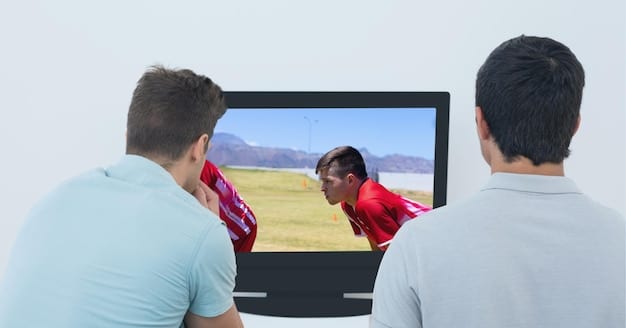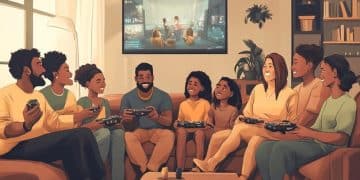Reality TV’s Impact on Social Media: Trends & Influence

Reality TV’s impact on social media is significant, driving trends and influencing audience behavior through interactive formats and real-time engagement.
Reality TV’s impact on social media: how shows drive trends and influence audiences is undeniable in today’s digital landscape. These programs have evolved from mere entertainment to powerful forces shaping online conversations and behaviors.
The Rise of Reality TV and Social Media
Reality TV has come a long way since its early days. From shows like “The Real World” that pioneered the genre, we now have a plethora of options ranging from dating competitions to culinary battles. Concurrently, social media has exploded, becoming an integral part of our daily lives.
The intersection of these two phenomena is where things get interesting. Reality TV shows have learned to leverage social media to amplify their reach, while social media platforms benefit from the real-time engagement and trends that these shows generate. Let’s delve into how this relationship has evolved.
Early Days of Interaction
Initially, interactions were simple. Shows might encourage viewers to vote via text message or offer behind-the-scenes content on their websites. Social media was in its infancy, but even then, the potential for direct engagement was apparent.
Modern Integration
Today, the integration is seamless. Shows often have dedicated hashtags, social media challenges, and even incorporate user-generated content. Cast members are active on platforms like Instagram, TikTok, and Twitter, engaging with fans and driving conversation.
- Hashtag Campaigns: Shows create unique hashtags to encourage viewers to share their thoughts and reactions.
- Social Media Challenges: Challenges inspired by the show can go viral, increasing visibility and engagement.
- Cast Member Interaction: Cast members use their personal accounts to provide updates, behind-the-scenes content, and interact with fans.
In conclusion, the relationship between reality TV and social media has evolved from basic engagement to a complex ecosystem. Shows now use social media as a vital component of their marketing strategy, while platforms benefit from the sustained attention and trending topics these shows provide.
How Reality TV Drives Social Media Trends
One of the most notable aspects of reality TV is its ability to set social media trends. Whether it’s a memorable catchphrase, a unique style choice, or a controversial moment, these shows often spark widespread conversation and influence online behavior.
Let’s examine some specific ways reality TV steers the direction of social media trends, creating ripple effects that impact various facets of digital culture.
Catchphrases and Memes
Reality TV is a breeding ground for iconic catchphrases and memes. These snippets of dialogue or visual moments often take on a life of their own, spreading rapidly across social media platforms.
Fashion and Beauty Trends
The fashion and beauty choices of reality TV stars often influence viewers. What contestants wear or how they style their hair can quickly become the latest trend, driving sales and shaping consumer preferences.

- Catchphrase Longevity: Catchphrases can remain relevant for years, often resurfacing in new contexts.
- Rapid Adoption: Fashion and beauty trends can spread rapidly through social media, influencing large audiences.
- Commercial Impact: The trends often translate into increased sales for related products and services.
In conclusion, reality TV wields significant power in driving social media trends. From memorable catchphrases to influential fashion choices, these shows continuously shape online culture and consumer behavior.
The Impact on Audience Engagement
Reality TV shows excel at fostering audience engagement. The interactive nature of these programs, combined with the real-time aspect of social media, creates a dynamic environment where viewers feel deeply connected to the content and the cast.
Let’s probe into the mechanisms that promote audience engagement and how these shows have changed the viewer’s experience.
Real-Time Interaction
Social media enables real-time interaction between viewers and the show. Live tweeting, polls, and Q&A sessions allow audiences to participate actively in the viewing experience.
Emotional Investment
Reality TV thrives on emotional investment. Viewers become invested in the lives and relationships of the cast members, leading to stronger engagement and loyalty.
- Active Participation: Real-time interaction encourages viewers to become active participants rather than passive observers.
- Community Building: Shared emotional experiences help build online communities around the show.
- Extended Engagement: Social media keeps the conversation going even after the show ends, extending engagement over time.
In conclusion, reality TV significantly impacts audience engagement by combining interactive formats with real-time social media interactions. This creates a dynamic environment where viewers feel deeply connected to the content and cast, enhancing loyalty and extending engagement.
The Rise of Influencer Culture
Reality TV has played a significant role in the rise of influencer culture. Many of today’s top influencers got their start on these shows, using their newfound fame to build lucrative careers on social media.
Let’s understand how reality TV functions as a launchpad for influencers and the broader implications of this phenomenon.
Reality Stars to Influencers
Appearing on a reality TV show offers instant visibility and a built-in audience. Many contestants leverage this platform to transition into full-time influencers, endorsing products, creating content, and partnering with brands.
Authenticity and Relatability
Viewers often perceive reality TV stars as more authentic and relatable than traditional celebrities. This relatability makes them effective influencers, as their endorsements carry more weight with their followers.
- Instant Visibility: Reality TV provides a platform for contestants to gain immediate recognition.
- Direct Access to Audience: Social media allows reality TV stars to communicate directly with their fans.
- Brand Partnerships: Influencers can monetize their following through partnerships with brands that align with their personal brand.
To conclude, reality TV is pivotal in the rise of influencer culture. By offering instant visibility and fostering relatability, these shows serve as a launchpad for individuals to build influential and profitable careers on social media, endorsing products, creating content, and partnering with brands.
Negative Impacts: Cyberbullying and Online Harassment
While reality TV’s impact on social media is largely positive, there are also negative consequences to consider. Cyberbullying and online harassment are common issues, often targeting contestants and sparking toxic online environments.
Let’s look at the darker aspects of this intersection and what measures can be taken to address the problems it raises.
Targeted Harassment
Reality TV contestants are often subjected to intense scrutiny and criticism. This can escalate into targeted harassment, with viewers attacking their appearance, behavior, or personal lives.
The Spread of Misinformation
Social media can amplify misinformation about contestants, leading to further harassment and negativity. False rumors and misleading narratives can quickly go viral, damaging reputations and causing emotional distress.

- Mental Health Impact: Cyberbullying and harassment can have serious mental health consequences for contestants.
- Responsibility of Networks: Reality TV networks have a responsibility to protect their contestants from online abuse.
- Community Standards: Social media platforms need to enforce community standards and address cyberbullying effectively.
In conclusion, while reality TV and social media offer numerous benefits, the negative impacts of cyberbullying and online harassment cannot be ignored. Targeted harassment and the spread of misinformation can have severe consequences for contestants’ mental health, emphasizing the need for networks and platforms to take responsibility and enforce community standards to protect individuals from online abuse.
The Future of Reality TV and Social Media
The symbiotic relationship between reality TV and social media is set to deepen even further. As technology evolves, we can expect to see new forms of interaction, greater personalization, and even more direct influence on audience behavior.
Let’s explore what the future may hold for this influential pairing, focusing on changes in technology and the increasing effect on viewers.
Interactive Formats
Future reality TV shows may incorporate augmented reality (AR) and virtual reality (VR) elements, allowing viewers to participate in the show in new and immersive ways.
Personalized Content
AI-powered algorithms can analyze social media data to personalize content recommendations and tailor the viewing experience to individual preferences.
- Enhanced Engagement: Interactive formats will make viewers feel even more connected to the show.
- Customized Experiences: Personalized content will cater to individual tastes and preferences.
- Greater Influence: Social media will become an even more powerful tool for shaping audience behavior and driving trends.
In conclusion, the future between reality TV and social media promises deeper integration and influence. Interactive formats, personalized content driven by AI, and enhanced engagement will reshape the viewing experience, making social media an even more powerful tool for shaping audience behavior and driving trends.
| Key Aspect | Brief Description |
|---|---|
| 📺 Social Trends | Reality TV drives trends through catchphrases and styles. |
| 🗣️ Audience Engagement | Encourages real-time interaction and emotional investment. |
| 🌟 Influencer Launchpad | Provides a platform for aspiring influencers to gain visibility. |
| 🚨 Negative Impacts | Includes cyberbullying and spread of misinformation. |
FAQ
▼
Reality TV shows influence social media trends by creating viral catchphrases, fashion trends, and sparking discussions around controversial moments, which quickly spread across various platforms.
▼
Audience engagement is crucial. Real-time interaction through live tweeting, polls, and active participation enhances viewer investment, fostering community building and loyalty to the show.
▼
Reality TV provides a platform. Contestants gain visibility and transition into full-time influencers by leveraging their fame for endorsements, content creation, and brand partnerships.
▼
Negative impacts include cyberbullying, targeted harassment of contestants, and the spread of misinformation, which can lead to mental health issues and toxic online environments.
▼
The influence will deepen with interactive formats like AR/VR, personalized content through AI, and more direct engagement, solidifying social media’s role in shaping audience behavior and trends.
Conclusion
In summary, the interplay between reality TV and social media wields a significant influence on modern culture. From setting trends and fostering engagement to launching influencer careers, this relationship is dynamic and multifaceted. While negative aspects like cyberbullying cannot be ignored, the integration of these two realms continues to evolve, promising new forms of interaction and even greater impact in the future.





